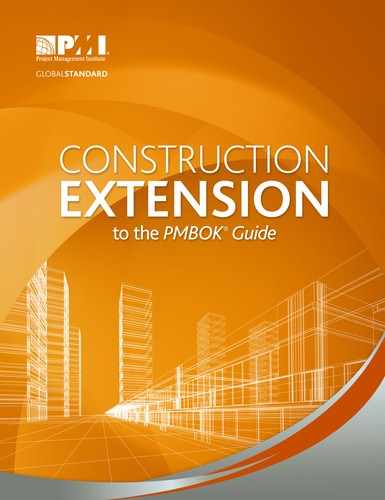APPENDIX X3
MOST COMMON CAUSES OF RISKS IN CONSTRUCTION PROJECTS
Some typical key risks and potential sources of risks in construction projects can be identified according to the following indicated categories. This list is not intended to be exhaustive but rather informative; there are many other ways to classify risks for identification purposes specific to the project. Performing organizations should develop their own list appropriate for the type of project in which they engage.
X3.1Design/Technical Risks:
- Inadequate and incomplete design;
- Incomplete knowledge of local site conditions;
- Inaccurate technical assumptions;
- Insufficient technical background and experience on specific project type and local characteristics;
- Incorrect selection of equipment, materials, and building techniques;
- Incorrect geotechnical and foundation estimations and structural design;
- Unavailability and incorrect capacity of utility services;
- Errors and omissions by consultants;
- Lack of specialized technical consultants on critical aspects of the project;
- Over-involvement of the owner in design;
- Continuous changes to the project scope;
- Delays in obtaining client concurrence;
- Design scope exceeding available budget;
- Uncertainty in the total cost estimate due to uncertain quantities and unit prices during the planning and initial design phase; and
- Incomplete project cost estimate and inaccurate project schedule.
X3.2Construction Risks:
X3.2.1 Contractors, Subcontractors, and Suppliers
- Contractor and/or subcontractor capability,
- Inefficient coordination of project plans,
- Unavailability of sufficient and skilled human resources,
- Unavailability in time of special materials and construction equipment and equipment breakdowns,
- Equipment commissioning,
- Unsuitable equipment and materials,
- Low level of competency in management (especially subcontractors),
- Incomplete knowledge and training on specific construction techniques,
- Construction occupational safety,
- Lack of environmental training and knowledge of workers on site,
- Restricted work hours, and
- Health and safety regulations and responsibilities.
X3.2.2 Technical Factors
- Changes in work orders,
- Low level of documented detail design,
- Lack of scheduled instructions and drawing documents,
- Gap between theory and actual quantities of work, and
- Unexpected costs of tests and samples.
X3.2.3 Site and Layout Conditions
- Site access,
- Site security,
- Availability of resources,
- Availability and capacity of utility services,
- Resource overloading, and
- Interference between task fronts.
X3.2.4 Physical Factors
- Geological and geotechnical conditions,
- Sufficient and representative geotechnical and geological tests and samples,
- Groundwater level,
- Topography,
- Unforeseen subsurface conditions, and
- Unexpected climate conditions not covered under force majeure.
X3.2.5 Security Factors
- Corruption;
- Assault, vandalism, sabotage, and theft; and
- Intrusion and illegal occupancy of site.
X3.2.6 Contractual Factors
- Inaccurate contract time estimates;
- Insolvency of contractor, subcontractor, or supplier;
- Inadequate change orders procedure;
- Change orders negotiation;
- Unexpected work and extras;
- Delayed deliveries and disruptions;
- Delayed payment on contracts;
- Vendor appraisals; and
- Reliance on a single source.
X3.2.7 Performance Factors
- Defective work;
- Unskillfulness;
- Negligence and malicious acts;
- Labor disputes;
- Unsuitable materials;
- Construction productivity (labor and equipment);
- Accidents and injuries; and
- Critical lead times.
X3.3External Risks:
X3.3.1 Contractual Factors
- Tight project schedule,
- Client's quality and performance expectations higher than documented,
- Weak definition and documentation of project objectives (cost, schedule, scope, quality),
- Overlooked or new powerful and influencing stakeholders, and
- Influencing late changes in stakeholders’ requirements.
X3.3.2 Force Majeure Factors
- Market changes,
- Economic and political instability,
- Changes in regulations,
- Labor strikes,
- Adverse weather,
- Natural calamities, and
- Acts of God.
X3.3.3 Social Factors
- Competing interests between project and local communities,
- Working patterns linked to local cultural and religious factors,
- Culture and habits,
- Neighboring citizens rejecting the project, and
- Nongovernment organizations (NGOs) and environmental organizations opposing the project.
X3.3.4 Public Involvement
- Public perception distorted by media,
- Public exposure, and
- Citizen interest.
X3.3.5 Environmental Factors
- Unexpected additional environmental regulations;
- Environmental impact statement or assessment;
- Historical and artistic patrimony and archeological patrimony protection;
- Anthropological or biological interest (protection of endangered species, flora, and fauna); and
- Hazardous waste, noise, contamination, and emissions.
X3.3.6 Political Visibility, and Regulatory Factors
- Authorities with jurisdiction and vulnerability of political support;
- Regulatory institutions, government, and administration's statutory requirements or clearances;
- Changes in law, procedures, subsidies, policies and regulations, or project priorities;
- Complex administrative approval procedures;
- Obstruction of approvals;
- Bureaucracy;
- Environmental political pressures; and
- Political sensitivity and climate.
X3.4Organizational Risks:
- Culture;
- Attitudes;
- Disagreement about objectives;
- Insufficient resources;
- Inexperienced, inadequate, or undertrained staff;
- Internal approval complexities;
- Inconsistent cost, time, scope, and quality objectives; and
- Changes to prioritization of existing program.
X3.5Project Management Risks:
- Incomplete stakeholder identification;
- Overloaded team project portfolio;
- Insufficient resources assigned to the management of the project;
- Insufficient time to plan;
- Unanticipated project manager workload;
- Inexperienced, inadequate, or undertrained staff;
- Project team stability (lack of project team continuity, high rotation);
- Resource availability;
- Inadequate change request procedure;
- Communication breakdown within project team; and
- Project purpose definition, needs, objectives, costs, and deliverables that are poorly defined or understood.
X3.6Business Risks:
X3.6.1 Financial and Economical
- Funding and financing,
- Inflation rate volatility,
- Currency exchange rate fluctuations,
- National economic growth and recessions, and
- Loan interest rates.
X3.6.2 Planning, Monitoring, and Controlling
- Number of key project sponsors for decision making and management,
- Contractor selection procedure,
- Designer selection procedure,
- Selection of insurance,
- Priorities of the project,
- Control of key issues of the project, and
- Project management information systems.
X3.6.3 Land and Property, Statutory Clearance:
- Land acquisition;
- Clear title to land with appropriate zoning;
- Expropriation;
- Rights of way;
- Delay in land access agreements;
- Damage to neighboring properties; and
- Clearance from regulatory institutions, government, and administrations.
